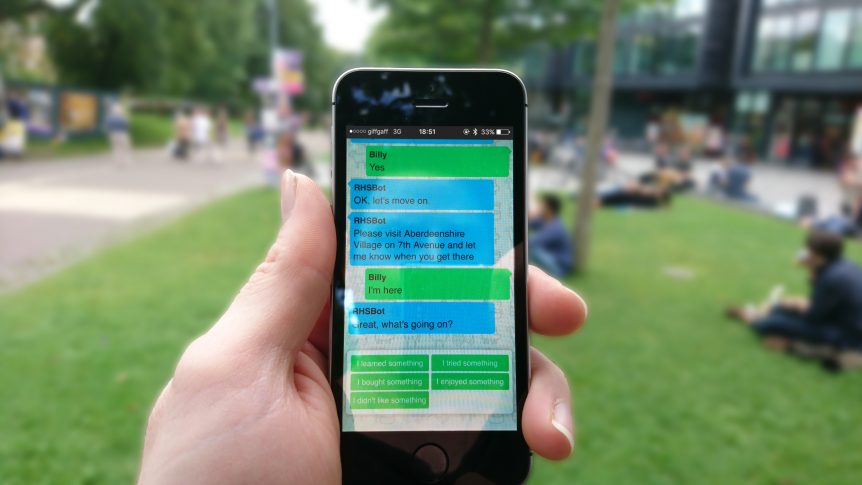Archive, Article
Chatbot ethnographer gathers data at the Royal Highland Show
The collection of ethnographic data to inform design and development of IoT is becoming increasingly challenging as interactions are woven seamlessly into the fabric of our lives and are often intermittent and on the go. As part of an ongoing collaboration with the Royal Bank of Scotland, the STiPS project has created a chatbot ethnographer or “Ethnobot” to assist with data collection at the Royal Highland Show, and we believe it has a wider application in the collection of ethnographic data for IoT development.
STiPS develops the Ethnobot
The STiPS project has been studying visitor transactions in festivals and markets. We have learned from ethnographic studies that people use evidence of their financial transaction histories (e.g. receipts and ticket stubs) as memory aides for recalling events in the aftermath of these busy, sometimes hectic, experiences. We are interested in collecting information about visitors’ transactions as they move through events, to inform the design of technology to support the process of both collecting and reviewing these transaction journeys in a joined up and compelling way. The Ethnobot was developed to encourage visitors at events to collect evidence and information around their value transactions throughout an experience, to provide us with data sets of complete transactions journeys so that we can understand what these look like and how best to support them.
The Ethnobot is currently in ‘app’ form, and runs on smart phones. It’s a simple chatbot implementation using little natural language processing, and instead uses a branching path structure to underpin its conversation with participants. The Ethnobot asks participants a series of questions in chat format as they move around an event. Introductory questions are provided with short preset responses for participants to select from. This enables participants to provide a quick response, whilst encouraging them to consider the values exchanged as part of their experiences. The preset response also leads to a preset next turn for the Ethnobot, which is likely to make sense. This is most often an open-ended question encouraging participants to elaborate and describe their transactions, activities and thoughts. The Ethnobot also encourages participants to use the smart phone camera to take photos of anything relating to a purchase or exchange of value. The Ethnobot integrates the photos into the dialogue, adding to the richness of the information collected. Finally, the Ethnobot sometimes directs participant activities, for example by suggesting an area of the show for them to visit and explore. This enables us build a data set that includes feedback from all participants on specific areas of the show.
Deployment at the Royal Highland Show
The Ethnobot was put through its first field trial at the Royal Highland Show in June, where 13 willing participants took the Ethnobot with them for a morning or an afternoon as part of their Royal Highland Show experience. Participants began by collecting a smart phone with the Ethnobot app from the research team, and then heading off into the show. Participants spent an average of one hour exploring with the Ethnobot and then returned to the research team to discuss their thoughts and experiences. The chat-logs and photo collections together with feedback from discussions are providing rich data sets which the STiPS team are currently analysing. Initial results suggest that despite the simplicity of the technology, the Ethnobot has been effective at collecting a broad range of valuable data from participants.
Powerful tool for ethnography
Whilst the Ethnobot has provided STiPS with useful information to address our research questions, it’s apparent that the Ethnobot could be used as a tool for ethnographic studies of IoT experiences more broadly. The Ethnobot has numerous advantages over a human ethnographer for studying experiences with the IoT. As people go about their daily lives there many spaces in which interactions with IoT tech takes place that would be off-limits to a human ethnographer, for example in people’s homes at night. The Ethnobot could be used at these times. Interactions with IoT are often outdoors and on the move, and interactions may be fleeting and sporadic. It’s therefore difficult for a human ethnographer to be there at just the right time, whereas the Ethnobot could. Or, there may be many people interacting with an IoT system at the same time, and it’s possible that multiple Ethnobots could capture data simultaneously. The Ethnobot also offers the capacity to collect other data streams in tandem with participant responses to questions, for example time and location stamps.
Next steps for the Ethnobot
From this study we aim to begin building an understanding about the benefits and drawbacks of deploying chatbot ethnographers, and develop guidance on how to get the best from them. The STiPS team will be exploring new functionality for future iterations of the Ethnobot. For example, we are interested in enabling a human ethnographer to join a chat in progress and take over temporarily from the Ethnobot, combining the best of both Ethnobot and human ethnographer.
For more information on the Ethnobot please contact: e.tallyn@ed.ac.uk

